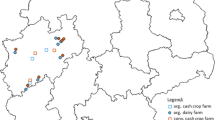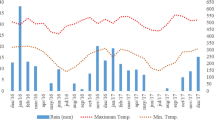Abstract
In the sandy regions of The Netherlands, high losses of N from intensified dairy farms are threatening the environment. Therefore, government defined decreasing maximum levy-free N surplusses for the period 1998–2008. On most dairy farms, the current N surplus has to be reduced by half at least. Farmers fear that realizing these surplusses will be expensive, because it limits application of animal manure, which then has to be exported or additional land has to be bought. Moreover, farmers are worried about the impact on soil fertility. To explore the possibilities for reducing surplusses of average intensive farms by improved nutrient management, farming systems research is carried out at prototype farm ‘De Marke’. Results are compared with results of a commercial farm in the mid-1980s, the moment that systems research started and introduction of the milk quota system put a halt to further intensification. Results indicate that average intensive farms can realise a reduction in N surplus to a level below the defined final maximum, without the need to buy land or to export slurry. Inputs of N in purchased feeds and fertilisers decreased by 56 and 78%, respectively. Important factors are reduced feed intake per unit milk, as a result of a higher milk yield per cow, less young stock and judicious feeding, an improved utilization of ‘home-made’ manure and a considered balance between the grassland and maize area. Changed soil fertility status did not constrain crop production. Nitrate concentration in the upper groundwater decreased from 200 to 50 mg l-1, within a few years.
Similar content being viewed by others
References
Aarts HFM (1996) Efficient nutrient management in dairy farming on sandy soils. Technical results of the experimental farm ‘De Marke’ for the years 1993/94 and 1994/95. Report 67 AB-DLO, Wageningen
Aarts HFM, Biewinga EE & Keulen H van (1992) Dairy farming systems based on efficient nutrient management. Neth J Agric Sci 40: 285–299
Aarts HFM, Habekotté B & Keulen H van (1999) Phosphorus (P) management in the ‘De Marke’ dairy farming system. Nutr Cycl Agroecosyst 56: 219–229 (this issue)
Beldman ACG & Prins H (1999) Analyse verschillen in mineralenoverschotten op gespecialiseerde melkveebedrijven (1996/1997). Rapport 2.99.01 LEI-DLO, Den Haag
Biewinga EE, Aarts HFM & Donker RA (1992) Melkveehouderij bij stringente milieunormen. ‘De Marke’ rapport 1, Hengelo
De Walle FB & Sevenster J (1998) Agriculture and the Environment; minerals, manure and measures. Kluwer Academic Publishers, Dordrecht
Fraters D, Boumans LMJ, Van Drecht G, De Haan T & De Hoop DW (1998) Nitrogen monitoring in groundwater in the sandy regions of The Netherlands. Van der Hoek KW, Erisman JW, Smeulers S, Wisniewski JR & Wisniewski J (eds) Proc. 1st Intern Nitrogen Conf. pp 479–485. Noordwijkerhout, The Netherlands
Habekotté B, Aarts HFM, Corré WJ, Hilhorst GJ, Keulen H van, Schröder JJ, Schoumans OF & Van der Schans FC (1998) Duurzame melkveehouderij en fosfaatmanagement. Recente (1990-1997) en te verwachten resultaten van proefbedrijf De Marke en de betekenis voor praktijkbedrijven. Rapport 92 ABDLO, Wageningen
Hack-ten Broeke MJD & De Groot WJM (1998) Evaluation of nitrate leaching risk at site and farm level. Nutr Cycl Agroecosyst 50: 271–276
Hart SC, Stark JM, Davidson EA & Firestone MK (1994) Nitrogen mineralisation, immobilization and nitrification. In: Weaver RW (ed) Methods of soil analysis, pp 985–1018. Soil Science Society of America Inc, Madison, Wis.
Jarvis SC, Wilkins RJ & Pain BF (1996) Opportunities for reducing the environmental impact of dairy farming management: a system approach. Grass Forage Sci 51: 21–31
Lekkerkerk LJA, Heij GJ & Hootsman MJM (1995) Ammonia: the facts. Report nr. 300-06, Dutch Priority Programme on Acidificaton, RIVM, Bilthoven
Leneman H, Oudendag DA, Van der Hoek KW & Janssen PHM (1998) Focus on emission factors: a sensitivity analysis of ammonia emission modelling in The Netherlands. In: Van der Hoek KW, Erisman JW, Smeulers S, Wisniewski JR & Wisniewski J (eds) Proc. 1st Int. Nitrogen Conf. pp 205–211. Noordwijkerhout, The Netherlands.
Meijs JAC, Walters RJK & Keen A (1982) Sward methods. In: Leaver JD (ed) Herbage Intake Handbook, pp 11–36. The British Grassl Soc, Grassl Res Inst, Hurley, Maidenhead, Berkshire, UK
Oenema O & Roest CWJ (1998) Nitrogen and phosphorus losses from agriculture into surface waters; the effects of policies and measures in the Netherlands. Wat Sci Tech 37: 19–30
Van den Brandt HP & Smit HP (1998) Mineral accounting: the way to combat eutrophication and to achieve the drinking water objective. Env Poll 102: 705–709
Van der Molen DT, Breeuwsma A & Boers PCM (1998) Agricultural nutrient losses to surface water in The Netherlands: impact, strategies and perspectives. J. Environ Qual 27: 4–11
Velthof GL & Oenema O (1997) Nitrous oxide emission from dairy farming systems in the Netherlands. Neth J Agric Sci 45: 347–360
Author information
Authors and Affiliations
Corresponding author
Rights and permissions
About this article
Cite this article
Aarts, H., Habekotté, B. & van Keulen, H. Nitrogen (N) management in the ‘De Marke’ dairy farming system. Nutrient Cycling in Agroecosystems 56, 231–240 (2000). https://doi.org/10.1023/A:1009885419512
Issue Date:
DOI: https://doi.org/10.1023/A:1009885419512




